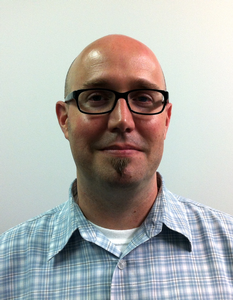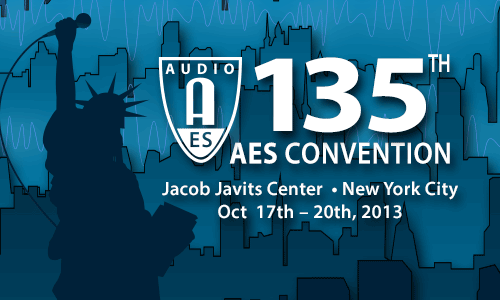
AES New York 2013
Networked Audio Session Details
Thursday, October 17, 4:30 pm — 6:00 pm (Room 1E13)
N1 - One Network to Rule Them All
Chair:Kevin Gross, AVA Networks - Boulder, CO, USA
Panelists:
Mattias Allevik, Video Corporation of America - New York, NY, USA
Dave Revel, Technical Multimedia Design, Inc. - Burbank, CA, USA
Abstract:
Networked audio distribution is now less frequently accomplished as a separate infrastructure. The promise of running audio on the same network as other facility services and applications is now coming to fruition. This workshop will discuss the motivation for combining services, the challenges in doing so, and requirements this approach puts on audio networking technologies.
 | This session is presented in association with the AES Technical Committee on Network Audio Systems |
Thursday, October 17, 6:00 pm — 7:00 pm (Room 1E13)
N2 - A Primer on Fundamental Concepts of Media Networking
Presenter:Landon Gentry, Audinate - Portland, OR, USA; Sydney, Australia
Abstract:
This session will cover the OSI model and how data travels through network layers (a “networking stack”): Layers 1, 2, 3 and 4; Cables, MAC Addresses, IP Addresses, and networking protocols. An overview of some networking standards and standards organizations, including the IEEE and the IETF. An introduction to IP data networking . . . it is how everything is already wired together. Identify some of the advantages and limitations of IP data networks with respect to real-time media. A brief discussion of IP networking standards and protocols that can be leveraged for media networking.
Friday, October 18, 2:30 pm — 3:30 pm (Room 1E13)
N3 - The Role of Standards in Audio Networking
Chair:Mark Yonge, Blakeney, Gloucestershire, UK
Panelists:
Jeff Berryman, Bosch Communications - Ithaca, NY, USA
Kevin Gross, AVA Networks - Boulder, CO, USA
Andreas Hildebrand, ALC NetworX - Munich, Germany
Lee Minich, Lab X Technologies - Rochester, NY, USA
Abstract:
A number of standards organizations and industry associations have been active in promoting standards relating to audio networks, such as EBU, IEC, and not least AES with recent standards AES64, AES67, and project X-210. Networks themselves are standardized under the auspices of bodies such as the IEEE and IETF. This session will describe the landscape of standards bodies and their areas of interest in audio networking and will examine the questions:
• Are standards important?
• How does all this standard activity impact the real world of audio networks?
• How do these standards benefit the marketplace, end users and the technology suppliers to this market?
• Is development of and adherence to standards better for suppliers and end users than letting the manufacturers’ proprietary solutions compete for market dominance?
Friday, October 18, 3:30 pm — 5:00 pm (Room 1E13)
N4 - Command and Control Protocols, Target Application Use Cases
Chair:Tim Shuttleworth, Renkus Heinz - Oceanside, CA, USA
Panelists:
Jeff Berryman, Bosch Communications - Ithaca, NY, USA
Andrew Eales, Wellington Institute of Technology - Wellington, New Zealand; Rhodes University - Grahamstown, South Africa
Richard Foss, Rhodes University - Grahamstown, Eastern Cape, South Africa
Jeff Koftinoff, Meyer Sound Canada - Vernon, BC, Canada
Abstract:
With the increasing utilization of data networks for the command and control of audio devices a number of protocols have been defined and promoted. These competing protocol initiatives, while providing methods suited to their target applications, have created confusion among potential adopters as to which protocol best fits their needs. In addition, the question is being asked, Why do we need so many “standard” protocols? At least four different industry organizations have involved themselves in some form of standardized protocol effort. AES is currently pursuing standardization of two such protocols, AES64 and X-210 (aka OCA). IEC has IEC62379, while IEEE is defining AVDECC (IEE1722.1) and ESTA offers ACN and there’s OSC from opensoundcontrol.org. This workshop addresses what differentiates these protocols by examining their target use applications.
 | This session is presented in association with the AES Technical Committee on Network Audio Systems |
Sunday, October 20, 11:00 am — 12:30 pm (Room 1E08)
N5 - X192 / AES67: How the New Networked Audio Interoperability Standard Was Designed
Chair:Greg Shay, The Telos Alliance - Cleveland, OH, USA
Panelists:
Kevin Gross, AVA Networks - Boulder, CO, USA
Stefan Heinzmann, Heinzmann - Konstanz, Germany
Andreas Hildebrand, ALC NetworX - Munich, Germany
Gints Linis, University of Latvia - IMCS - Riga, Latvia
Abstract:
It is said, to really understand a solution, you must clearly understand the problems it is solving. The nature of a technical specification like AES67 is that it is the end result of much discussion and deliberation. However, many of the intentions, the tradeoffs that were made, and an understanding of what problems were being solved, are not fully contained in the resulting document.
This panel will present the background of a number of the
decisions that were made and embodied into AES67. It will
describe the problems that were targeted to be solved, as best as they were understood. What were some of the difficult tradeoffs?
Networked audio will be new for some users, while some of the roots of the networked audio experience of the members of X192 go back 20 years. Given a proverbial clean slate by the AES, come listen to the reasons why the choices in AES67 were made.

